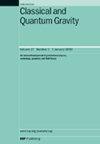Linearized gravity in the Starobinsky model: perturbative deviations from general relativity
IF 3.7
3区 物理与天体物理
Q2 ASTRONOMY & ASTROPHYSICS
引用次数: 0
Abstract
In this work, we linearize the field equations of f(R) gravity using the Starobinsky model, , and examine the modifications to general relativity (GR). We derive an equation for the trace, T, of the energy-momentum tensor, which we then decompose using an auxiliary field. This field satisfies the wave equation with T as its source, while simultaneously acting as an effective source for the classical deviation, , governed by the Klein–Gordon (KG) equation. The fields were expressed in terms of Green’s functions, whose symmetry properties facilitated the solution of the trace equation. Then was determined in terms of a modified or effective matter–energy distribution. From this, the effective energy density was obtained as the usual energy density T00, plus a perturbative correction proportional to m−2, involving the Laplacian of the integral of T, weighted by the retarded propagator of the KG equation. As an illustrative example, we numerically computed the perturbative term in a binary star system, evaluating it as a function of m and spatial position near the stars. In all cases, the results illustrate how the gravitational influence of the stars diminishes with distance, and how the perturbation decreases as m increases, consistently recovering the relativistic limit. Finally we computed the quadrupole components I11, I22, and I33 for m = 1 in the modified gravity model. The results show the same sinusoidal-squared structure as in GR, with I11 and I22 having equal but larger amplitudes, and I33 being negligible. We also numerically demonstrated that increasing m reduces the support of the Bessel-type function J1 modulated by a Heaviside factor, which governs the propagation close to the light cone, a physically expected effect. These results highlight the role of modified gravity corrections in the vicinity of compact objects.斯塔宾斯基模型中的线性化重力:广义相对论的微扰偏差
在这项工作中,我们使用Starobinsky模型线性化f(R)引力场方程,并检验广义相对论(GR)的修正。我们推导出能量动量张量轨迹T的方程,然后用辅助场分解它。该场满足以T为源的波动方程,同时作为经典偏差的有效源,由Klein-Gordon (KG)方程控制。这些场是用格林函数来表示的,格林函数的对称性有助于求解轨迹方程。然后根据修正的或有效的物质-能量分布来确定。由此,得到有效能量密度为通常的能量密度T00,加上与m−2成比例的微扰修正,涉及T积分的拉普拉斯量,由KG方程的延迟传播子加权。作为一个说明性的例子,我们数值计算了双星系统中的微扰项,并将其作为m和恒星附近空间位置的函数进行了评估。在所有情况下,结果都说明了恒星的引力影响如何随着距离的增加而减少,以及扰动如何随着m的增加而减少,并不断恢复相对论极限。最后,我们计算了修正重力模型中m = 1时的四极分量I11、I22和I33。结果显示与GR中相同的正弦平方结构,I11和I22具有相等但更大的振幅,而I33可以忽略不计。我们还在数值上证明,增加m会减少由Heaviside因子调制的贝塞尔型函数J1的支持,该函数控制光锥附近的传播,这是物理上预期的效果。这些结果强调了在致密天体附近修正重力修正的作用。
本文章由计算机程序翻译,如有差异,请以英文原文为准。
求助全文
约1分钟内获得全文
求助全文
来源期刊

Classical and Quantum Gravity
物理-天文与天体物理
CiteScore
7.00
自引率
8.60%
发文量
301
审稿时长
2-4 weeks
期刊介绍:
Classical and Quantum Gravity is an established journal for physicists, mathematicians and cosmologists in the fields of gravitation and the theory of spacetime. The journal is now the acknowledged world leader in classical relativity and all areas of quantum gravity.
 求助内容:
求助内容: 应助结果提醒方式:
应助结果提醒方式:


